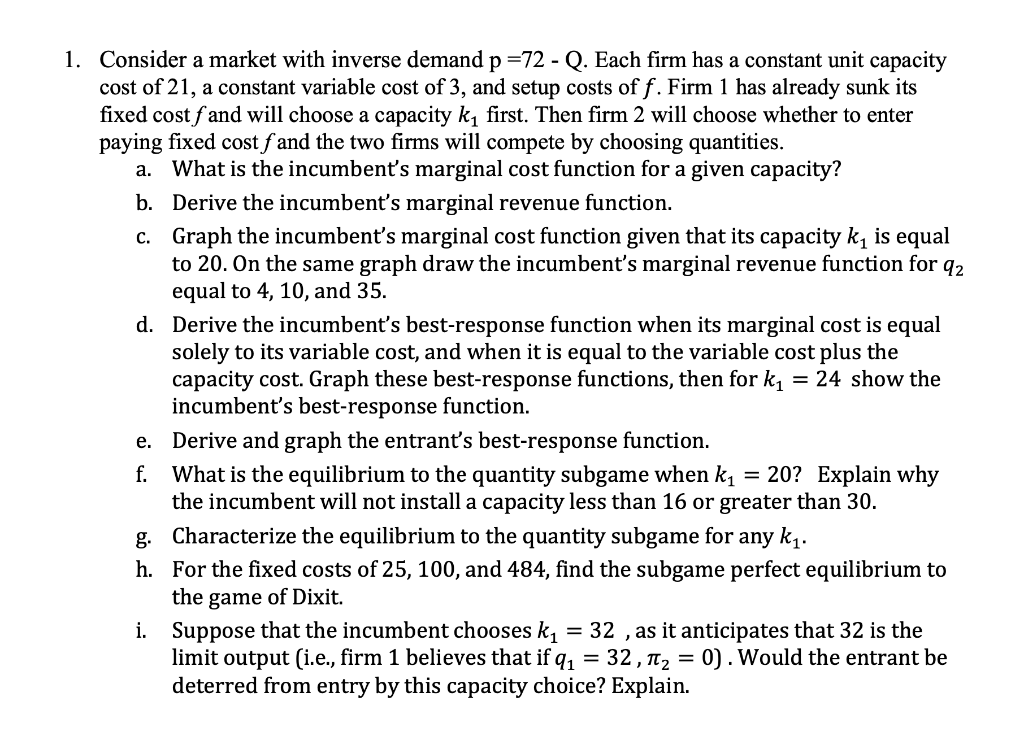
1. Consider a market with inverse demand p =72 - Q. Each firm has a constant unit capacity cost of 21, a constant variable cost of 3, and setup costs of f. Firm 1 has already sunk its fixed cost f and will choose a capacity ky first. Then firm 2 will choose whether to enter paying fixed cost f and the two firms will compete by choosing quantities. a. What is the incumbent's marginal cost function for a given capacity? b. Derive the incumbent's marginal revenue function. c. Graph the incumbent's marginal cost function given that its capacity k, is equal to 20. On the same graph draw the incumbent's marginal revenue function for 92 equal to 4, 10, and 35. d. Derive the incumbent's best-response function when its marginal cost is equal solely to its variable cost, and when it is equal to the variable cost plus the capacity cost. Graph these best-response functions, then for ky = 24 show the incumbent's best-response function. e. Derive and graph the entrant's best-response function. f. What is the equilibrium to the quantity subgame when k = 20? Explain why the incumbent will not install a capacity less than 16 or greater than 30. g. Characterize the equilibrium to the quantity subgame for any k. h. For the fixed costs of 25, 100, and 484, find the subgame perfect equilibrium to the game of Dixit. i. Suppose that the incumbent chooses k = 32 , as it anticipates that 32 is the limit output (i.e., firm 1 believes that if q = 32, 12 = 0). Would the entrant be deterred from entry by this capacity choice? Explain. 1. Consider a market with inverse demand p =72 - Q. Each firm has a constant unit capacity cost of 21, a constant variable cost of 3, and setup costs of f. Firm 1 has already sunk its fixed cost f and will choose a capacity ky first. Then firm 2 will choose whether to enter paying fixed cost f and the two firms will compete by choosing quantities. a. What is the incumbent's marginal cost function for a given capacity? b. Derive the incumbent's marginal revenue function. c. Graph the incumbent's marginal cost function given that its capacity k, is equal to 20. On the same graph draw the incumbent's marginal revenue function for 92 equal to 4, 10, and 35. d. Derive the incumbent's best-response function when its marginal cost is equal solely to its variable cost, and when it is equal to the variable cost plus the capacity cost. Graph these best-response functions, then for ky = 24 show the incumbent's best-response function. e. Derive and graph the entrant's best-response function. f. What is the equilibrium to the quantity subgame when k = 20? Explain why the incumbent will not install a capacity less than 16 or greater than 30. g. Characterize the equilibrium to the quantity subgame for any k. h. For the fixed costs of 25, 100, and 484, find the subgame perfect equilibrium to the game of Dixit. i. Suppose that the incumbent chooses k = 32 , as it anticipates that 32 is the limit output (i.e., firm 1 believes that if q = 32, 12 = 0). Would the entrant be deterred from entry by this capacity choice? Explain







